Related Research Articles

Penguins are a group of aquatic flightless birds from the family Spheniscidae of the order Sphenisciformes. They live almost exclusively in the Southern Hemisphere: only one species, the Galápagos penguin, is found north of the Equator. Highly adapted for life in the ocean water, penguins have countershaded dark and white plumage and flippers for swimming. Most penguins feed on krill, fish, squid and other forms of sea life which they catch with their bills and swallow whole while swimming. A penguin has a spiny tongue and powerful jaws to grip slippery prey.
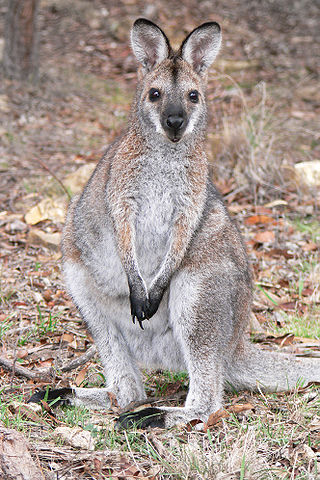
Macropodidae is a family of marsupials that includes kangaroos, wallabies, tree-kangaroos, wallaroos, pademelons, quokkas, and several other groups. These genera are allied to the suborder Macropodiformes, containing other macropods, and are native to the Australian continent, New Guinea and nearby islands.

Spiny lizards is a common name for the genus Sceloporus in the family Phrynosomatidae. The genus is endemic to North America, with various species ranging from New York, to Washington, and one occurring as far south as northern Panama. The greatest diversity is found in Mexico. This genus includes some of the most commonly seen lizards in the United States. Other common names for lizards in this genus include fence lizards, scaly lizards, bunchgrass lizards, and swifts.

Phytophthora is a genus of plant-damaging oomycetes, whose member species are capable of causing enormous economic losses on crops worldwide, as well as environmental damage in natural ecosystems. The cell wall of Phytophthora is made up of cellulose. The genus was first described by Heinrich Anton de Bary in 1875. Approximately 210 species have been described, although 100–500 undiscovered Phytophthora species are estimated to exist.
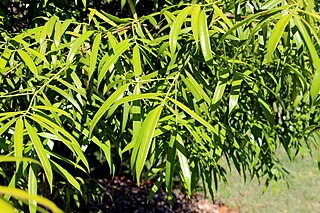
Sundacarpus is a monotypic genus of conifers containing a single species Sundacarpus amarus, belonging to the family Podocarpaceae. Sundacarpus was designated a genus by C.N.Page in 1989; formerly it had been classified variously as a species of Podocarpus or of Prumnopitys.

The Atherospermataceae, commonly known as the southern sassafrases, are a family of broadleaf evergreen trees and shrubs. The family includes 14 species in seven genera. The atherosperms are today mostly distributed in the Southern Hemisphere, with two species native to southern Chile and 12 species native to Australasia. Wood is commercially harvested from rainforest species of this family, and is used both in construction and in fine cabinet making.
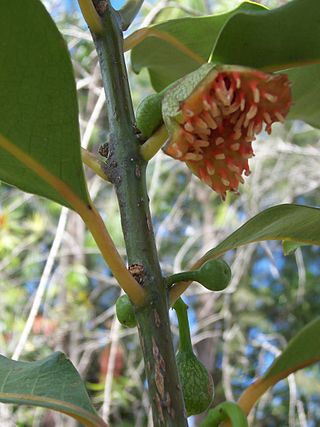
The Monimiaceae is a family of flowering plants in the magnoliid order Laurales. It is closely related to the families Hernandiaceae and Lauraceae. It consists of shrubs, small trees, and a few lianas of the tropics and subtropics, mostly in the southern hemisphere. The largest center of diversity is New Guinea, with about 75 species. Lesser centres of diversity are Madagascar, Australia, and the neotropics. Africa has one species, Xymalos monospora, as does Southern Chile. Several species are distributed through Malesia and the southwest Pacific.
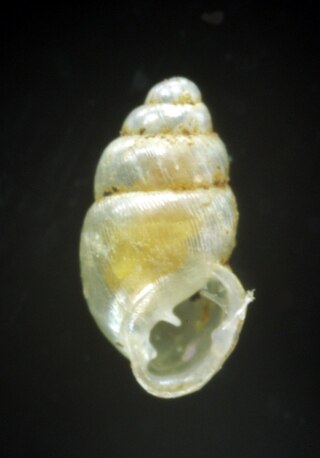
Carychium is a genus of very small air-breathing land snails, terrestrial pulmonate gastropod mollusks in the family Ellobiidae.

Argopecten irradians, formerly classified as Aequipecten irradians, common names Atlantic bay scallop, bay scallop, and blue-eyed scallop, is a species of scallop in the family Pectinidae. An edible saltwater clam, it is native to the northwest Atlantic from Cape Cod to the Gulf of Mexico.
Reuben Lasker was a fisheries scientist known for his contributions to larval ecology, particularly the Stable Ocean Hypothesis.
Raymondiceras is genus of ammonoid cephalopod belonging to the Cheiloceratidae family. Species belonging to this genus lived in late Devonian (Famennian).

Calycoceras is an extinct genus of cephalopods belonging to the subclass Ammonoidea and family Acanthoceratidae that lived during the Cenomanian stage of the Late Cretaceous, 100-94 Mya. Their shells had ornate ribs.

Crotalocrinites, also known as the feather star, is a genus of extinct sea lily belonging to the family Crotalocrinitidae. These feather stars were stationary intermediate-level organisms feeding on suspension epifauna. They lived in the Silurian period, from the Upper Wenlock age to the Ludlow age.
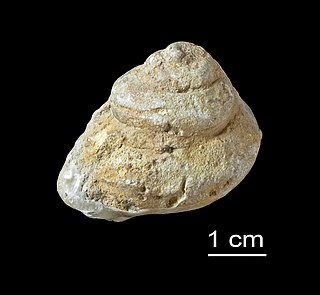
Holopea is an extinct genus of fossil sea snails, Paleozoic gastropod mollusks in the family Holopeidae.

Beloceras is a genus of ammonites included in the family Beloceratidae. These fast-moving nektonic carnivores lived in the Late Devonian period, from 379.5 to 376.1 Ma.
Sweetognathus is an extinct genus of conodonts in the family Sweetognathidae that evolved at the beginning of the Permian period, in near-equatorial, shallow-water seas.
Domanikoceras is monospecific genus of ammonoids that lived during the lower Frasnian stage of upper Devonian period and was named after Domanic Suite in the Timan (Russia). Compressed and smooth shell of these ammonoids had closed umbilicus. Suture was the same as in the gase of genus Tornoceras, while growth lines were similar to Cheiloceratidae, as they were strictly convex. The only species belonging to this genus is D. timidum and its name has been derived from Latin word timid (shy) because course of its aperture has protecting course.
The Aksu Basin is a sedimentary basin in southwestern Turkey, around the present-day Aksu River. Located at the intersection of several major tectonic systems, in the Isparta Angle, the Aksu Basin covers an area of some 2000 square kilometers. Together with the Köprü Çay Basin and the Manavgat Basin, the Aksu Basin forms part of the broader Antalya Basin. It forms a graben relative to the surrounding Anatolian plateau.
References
- 1 2 3 "Goniat database" . Retrieved 20 May 2016.
- 1 2 Korn D, Klug C (2002) Ammoneae Devonicae. Fossilium Catalogus 138. Backhuys, Leiden
- 1 2 3 "Paleobiology Database" . Retrieved 17 December 2021.